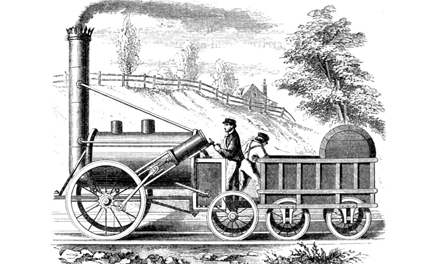
George and Robert Stephenson
This father-and-son partnership were the pioneers of the railways. George Stephenson (1781-1848) never went to school but his great talent was in mechanical engineering. His son, Robert Stephenson (1803-59), also a Northumbrian lad, worked with his father and became a brilliant civil engineer and administrator. Their 4’8¾” gauge became the standard for all railways.
Prior to 1814, when George Stephenson invented the first steam locomotive, transportation of coal was by horse-drawn wagons, road, canal or by sea along the coastline, but these were reaching the limit of their capacity. The steam locomotive, running on purpose-built cast-iron rails, was a great advance even though it only ran at 5 or 6mph. The 27-mile Stockton & Darlington railway was opened in 1825 and was the world’s first freight and passenger service.
Robert Stephenson developed the Rocket locomotive for the Liverpool & Manchester railway which opened in 1830. This ran at 35mph, amazing for the time. Orders poured in and the age of travel was born. He oversaw the construction of a third of the country’s railway network, including the London to Birmingham engineering masterpiece. His expertise also turned to bridge-building and he was an MP from 1847 until his death. He declined a knighthood but it would have been richly deserved.
(Top image: from Smiles (1868) / Public domain)
